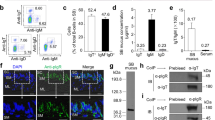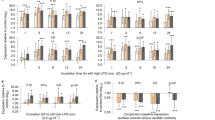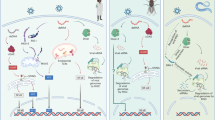Abstract
Recent years have witnessed a renaissance in the study of fish immune systems. Such studies have greatly expanded the knowledge of the evolution and diversification of vertebrate immune systems. Several findings in those studies have overturned old paradigms about the immune system and led to the discovery of novel aspects of mammalian immunity. Here I focus on how findings pertaining to immunity in teleost (bony) fish have led to major new insights about mammalian B cell function in innate and adaptive immunity. Additionally, I illustrate how the discovery of the most ancient mucosal immunoglobulin described thus far will help resolve unsettled paradigms of mammalian mucosal immunity.
This is a preview of subscription content, access via your institution
Access options
Subscribe to this journal
Receive 12 print issues and online access
$209.00 per year
only $17.42 per issue
Buy this article
- Purchase on Springer Link
- Instant access to full article PDF
Prices may be subject to local taxes which are calculated during checkout


Similar content being viewed by others
References
Hoffmann, J. Antifungal defense in Drosophila. Nat. Immunol. 8, 543–545 (2007).
Kaufmann, S.H. Immunology's foundation: the 100-year anniversary of the Nobel Prize to Paul Ehrlich and Elie Metchnikoff. Nat. Immunol. 9, 705–712 (2008).
Magnadóttir, B. Innate immunity of fish (overview). Fish Shellfish Immunol. 20, 137–151 (2006).
Magor, B.G. & Magor, K.E. Evolution of effectors and receptors of innate immunity. Dev. Comp. Immunol. 25, 651–682 (2001).
Flajnik, M.F. & Kasahara, M. Origin and evolution of the adaptive immune system: genetic events and selective pressures. Nat. Rev. Genet. 11, 47–59 (2010).
Zapata, A. & Amemiya, C.T. Phylogeny of lower vertebrates and their immunological structures. Curr. Top. Microbiol. Immunol. 248, 67–107 (2000).
Salinas, I., Zhang, Y.A. & Sunyer, J.O. Mucosal immunoglobulins and B cells of teleost fish. Dev. Comp. Immunol. 35, 1346–1365 (2011).
Vasta, G.R. et al. Structural and functional diversity of the lectin repertoire in teleost fish: relevance to innate and adaptive immunity. Dev. Comp. Immunol. 35, 1388–1399 (2011).
Yoder, J.A. & Litman, G.W. The phylogenetic origins of natural killer receptors and recognition: relationships, possibilities, and realities. Immunogenetics 63, 123–141 (2011).
Sunyer, J.O., Zarkadis, I.K. & Lambris, J.D. Complement diversity: a mechanism for generating immune diversity? Immunol. Today 19, 519–523 (1998).
Danilova, N., Bussmann, J., Jekosch, K. & Steiner, L.A. The immunoglobulin heavy-chain locus in zebrafish: identification and expression of a previously unknown isotype, immunoglobulin Z. Nat. Immunol. 6, 295–302 (2005).
Hansen, J.D., Landis, E.D. & Phillips, R.B. Discovery of a unique Ig heavy-chain isotype (IgT) in rainbow trout: Implications for a distinctive B cell developmental pathway in teleost fish. Proc. Natl. Acad. Sci. USA 102, 6919–6924 (2005).
Sunyer, J.O. (ed.) Special issue on teleost fish immunology. Dev. Comp. Immunol 35, 1193–1400 (2011).
Neumann, N.F., Stafford, J.L., Barreda, D., Ainsworth, A.J. & Belosevic, M. Antimicrobial mechanisms of fish phagocytes and their role in host defense. Dev. Comp. Immunol. 25, 807–825 (2001).
Rabinovitch, M. Professional and non-professional phagocytes: an introduction. Trends Cell Biol. 5, 85–87 (1995).
Wu, Y. et al. Human gamma delta T cells: a lymphoid lineage cell capable of professional phagocytosis. J. Immunol. 183, 5622–5629 (2009).
Ochando, J.C. et al. Alloantigen-presenting plasmacytoid dendritic cells mediate tolerance to vascularized grafts. Nat. Immunol. 7, 652–662 (2006).
Li, J. et al. B lymphocytes from early vertebrates have potent phagocytic and microbicidal abilities. Nat. Immunol. 7, 1116–1124 (2006).
Øverland, H.S., Pettersen, E.F., Ronneseth, A. & Wergeland, H.I. Phagocytosis by B-cells and neutrophils in Atlantic salmon (Salmo salar L.) and Atlantic cod (Gadus morhua L.). Fish Shellfish Immunol. 28, 193–204 (2009).
Zimmerman, L.M., Vogel, L.A., Edwards, K.A. & Bowden, R.M. Phagocytic B cells in a reptile. Biol. Lett. 6, 270–273 (2010).
Parra, D. et al. Pivotal Advance: Peritoneal cavity B-1 B cells have phagocytic and microbicidal capacities and present phagocytosed antigen to CD4+ T cells. J. Leukoc. Biol. 91, 525–536 (2012).
Gao, X.M. et al. A novel function of murine B1 cells: Active phagocytic and microbicidal abilities. Eur. J. Immunol 42, 982–992 (2012).
Nakashima, M. et al. Pivotal Advance: characterization of mouse liver phagocytic B cells in innate immunity. J. Leukoc. Biol. 91, 537–546 (2012).
Herzenberg, L.A., Kantor, A.B. & Herzenberg, L.A. Layered evolution in the immune system. A model for the ontogeny and development of multiple lymphocyte lineages. Ann. NY Acad. Sci. 651, 1–9 (1992).
Casali, P. & Schettino, E.W. Structure and function of natural antibodies. Curr. Top. Microbiol. Immunol. 210, 167–179 (1996).
Zhou, Z.H. et al. The broad antibacterial activity of the natural antibody repertoire is due to polyreactive antibodies. Cell Host Microbe 1, 51–61 (2007).
Murakami, M. et al. Oral administration of lipopolysaccharides activates B-1 cells in the peritoneal cavity and lamina propria of the gut and induces autoimmune symptoms in an autoantibody transgenic mouse. J. Exp. Med. 180, 111–121 (1994).
Ha, S.A. et al. Regulation of B1 cell migration by signals through Toll-like receptors. J. Exp. Med. 203, 2541–2550 (2006).
Viau, M. & Zouali, M. B-lymphocytes, innate immunity, and autoimmunity. Clin. Immunol. 114, 17–26 (2005).
Fritz, J.H. et al. Acquisition of a multifunctional IgA+ plasma cell phenotype in the gut. Nature 481, 199–203 (2012).
Itakura, A. et al. An hour after immunization peritoneal B-1 cells are activated to migrate to lymphoid organs where within 1 day they produce IgM antibodies that initiate elicitation of contact sensitivity. J. Immunol. 175, 7170–7178 (2005).
Rodriguez-Manzanet, R. et al. T and B cell hyperactivity and autoimmunity associated with niche-specific defects in apoptotic body clearance in TIM-4-deficient mice. Proc. Natl. Acad. Sci. USA 107, 8706–8711 (2010).
Boes, M. et al. Accelerated development of IgG autoantibodies and autoimmune disease in the absence of secreted IgM. Proc. Natl. Acad. Sci. USA 97, 1184–1189 (2000).
Ehrenstein, M.R. & Notley, C.A. The importance of natural IgM: scavenger, protector and regulator. Nat. Rev. Immunol. 10, 778–786 (2010).
Chen, Y., Park, Y.B., Patel, E. & Silverman, G.J. IgM antibodies to apoptosis-associated determinants recruit C1q and enhance dendritic cell phagocytosis of apoptotic cells. J. Immunol. 182, 6031–6043 (2009).
Steinman, R.M., Turley, S., Mellman, I. & Inaba, K. The induction of tolerance by dendritic cells that have captured apoptotic cells. J. Exp. Med. 191, 411–416 (2000).
Hayakawa, K. et al. Positive selection of natural autoreactive B cells. Science 285, 113–116 (1999).
Henson, P.M. Dampening inflammation. Nat. Immunol. 6, 1179–1181 (2005).
Lund, F.E. & Randall, T.D. Effector and regulatory B cells: modulators of CD4+ T cell immunity. Nat. Rev. Immunol. 10, 236–247 (2010).
Barr, T.A., Brown, S., Ryan, G., Zhao, J. & Gray, D. TLR-mediated stimulation of APC: distinct cytokine responses of B cells and dendritic cells. Eur. J. Immunol. 37, 3040–3053 (2007).
Mizoguchi, A. & Bhan, A.K. A case for regulatory B cells. J. Immunol. 176, 705–710 (2006).
Hoehlig, K. et al. Immune regulation by B cells and antibodies a view towards the clinic. Adv. Immunol. 98, 1–38 (2008).
Morris, D.L. & Rothstein, T.L. Abnormal transcription factor induction through the surface immunoglobulin M receptor of B-1 lymphocytes. J. Exp. Med. 177, 857–861 (1993).
Haas, K.M., Poe, J.C., Steeber, D.A. & Tedder, T.F. B-1a and B-1b cells exhibit distinct developmental requirements and have unique functional roles in innate and adaptive immunity to S. pneumoniae. Immunity 23, 7–18 (2005).
Gil-Cruz, C. et al. The porin OmpD from nontyphoidal Salmonella is a key target for a protective B1b cell antibody response. Proc. Natl. Acad. Sci. USA 106, 9803–9808 (2009).
Baumgarth, N. The double life of a B-1 cell: self-reactivity selects for protective effector functions. Nat. Rev. Immunol. 11, 34–46 (2011).
Hastings, W.D., Tumang, J.R., Behrens, T.W. & Rothstein, T.L. Peritoneal B-2 cells comprise a distinct B-2 cell population with B-1b-like characteristics. Eur. J. Immunol. 36, 1114–1123 (2006).
Griffin, D.O., Holodick, N.E. & Rothstein, T.L. Human B1 cells in umbilical cord and adult peripheral blood express the novel phenotype CD20+ CD27+ CD43+ CD70. J. Exp. Med. 208, 67–80 (2011).
Zhang, Y.A. et al. IgT, a primitive immunoglobulin class specialized in mucosal immunity. Nat. Immunol. 11, 827–835 (2010).
Macpherson, A.J. et al. A primitive T cell-independent mechanism of intestinal mucosal IgA responses to commensal bacteria. Science 288, 2222–2226 (2000).
Suzuki, K., Ha, S.A., Tsuji, M. & Fagarasan, S. Intestinal IgA synthesis: a primitive form of adaptive immunity that regulates microbial communities in the gut. Semin. Immunol. 19, 127–135 (2007).
Cerutti, A., Chen, K. & Chorny, A. Immunoglobulin responses at the mucosal interface. Annu. Rev. Immunol. 29, 273–293 (2011).
Kang, H.S. et al. Signaling via LTbetaR on the lamina propria stromal cells of the gut is required for IgA production. Nat. Immunol. 3, 576–582 (2002).
Macpherson, A.J., McCoy, K.D., Johansen, F.E. & Brandtzaeg, P. The immune geography of IgA induction and function. Mucosal Immunol. 1, 11–22 (2008).
Rawls, J.F., Samuel, B.S. & Gordon, J.I. Gnotobiotic zebrafish reveal evolutionarily conserved responses to the gut microbiota. Proc. Natl. Acad. Sci. USA 101, 4596–4601 (2004).
Kanther, M. & Rawls, J.F. Host-microbe interactions in the developing zebrafish. Curr. Opin. Immunol. 22, 10–19 (2010).
Boehm, T. Design principles of adaptive immune systems. Nat. Rev. Immunol. 11, 307–317 (2011).
Litman, G.W. & Cooper, M.D. Why study the evolution of immunity? Nat. Immunol. 8, 547–548 (2007).
Warr, G.W. The adaptive immune system of fish. Dev. Biol. Stand. 90, 15–21 (1997).
Solem, S.T. & Stenvik, J. Antibody repertoire development in teleosts-a review with emphasis on salmonids and Gadus morhua L. Dev. Comp. Immunol. 30, 57–76 (2006).
Cain, K.D., Jones, D.R. & Raison, R.L. Antibody-antigen kinetics following immunization of rainbow trout (Oncorhynchus mykiss) with a T-cell dependent antigen. Dev. Comp. Immunol. 26, 181–190 (2002).
Cain, K.D., Jones, D.R. & Raison, R.L. Characterisation of mucosal and systemic immune responses in rainbow trout (Oncorhynchus mykiss) using surface plasmon resonance. Fish Shellfish Immunol. 10, 651–666 (2000).
Maki, J.L. & Dickerson, H.W. Systemic and cutaneous mucus antibody responses of channel catfish immunized against the protozoan parasite Ichthyophthirius multifiliis. Clin. Diagn. Lab. Immunol. 10, 876–881 (2003).
Kaattari, S., Evans, D. & Klemer, J. Varied redox forms of teleost IgM: an alternative to isotypic diversity? Immunol. Rev. 166, 133–142 (1998).
Ye, J., Kaattari, I. & Kaattari, S. Plasmablasts and plasma cells: reconsidering teleost immune system organization. Dev. Comp. Immunol. 35, 1273–1281 (2011).
Kaattari, S.L., Zhang, H.L., Khor, I.W., Kaattari, I.M. & Shapiro, D.A. Affinity maturation in trout: clonal dominance of high affinity antibodies late in the immune response. Dev. Comp. Immunol. 26, 191–200 (2002).
Edholm, E.S., Bengten, E. & Wilson, M. Insights into the function of IgD. Dev. Comp. Immunol. 35, 1309–1316 (2011).
Ramirez-Gomez, F. et al. Discovery and characterization of secretory IgD in rainbow trout: secretory IgD is produced through a novel splicing mechanism. J. Immunol. 188, 1341–1349 (2012).
Edholm, E.S. et al. Identification of two IgD+ B cell populations in channel catfish, Ictalurus punctatus. J. Immunol. 185, 4082–4094 (2010).
Chen, K. et al. Immunoglobulin D enhances immune surveillance by activating antimicrobial, proinflammatory and B cell-stimulating programs in basophils. Nat. Immunol. 10, 889–898 (2009).
Ye, J., Bromage, E.S. & Kaattari, S.L. The strength of B cell interaction with antigen determines the degree of IgM polymerization. J. Immunol. 184, 844–850 (2010).
Saunders, H.L., Oko, A.L., Scott, A.N., Fan, C.W. & Magor, B.G. The cellular context of AID expressing cells in fish lymphoid tissues. Dev. Comp. Immunol. 34, 669–676 (2010).
Cannon, J.P. et al. A bony fish immunological receptor of the NITR multigene family mediates allogeneic recognition. Immunity 29, 228–237 (2008).
Acknowledgements
I thank L. King and D. Parra for critical reading and editing of the manuscript. Supported by the National Science Foundation (NSF-MCB-0719599), the US National Institutes of Health (R01GM085207-01), the US Department of Agriculture (USDA-NRI 2006-01619 and USDA-NRI 2007-01719).
Author information
Authors and Affiliations
Corresponding author
Ethics declarations
Competing interests
The author declares no competing financial interests.
Rights and permissions
About this article
Cite this article
Sunyer, J. Fishing for mammalian paradigms in the teleost immune system. Nat Immunol 14, 320–326 (2013). https://doi.org/10.1038/ni.2549
Received:
Accepted:
Published:
Issue Date:
DOI: https://doi.org/10.1038/ni.2549
This article is cited by
-
Molecular characterization of a new IgZ3 subclass in common carp (Cyprinus carpio) and comparative expression analysis of IgH transcripts during larvae development
BMC Veterinary Research (2021)
-
Effects of underwater and semi-aquatic environments on gut tissue and microbiota of the mudskipper Boleophthalmus pectinirostris
Journal of Comparative Physiology B (2021)
-
Modulatory role of dietary Thymus vulgaris essential oil and Bacillus subtilis against thiamethoxam-induced hepatorenal damage, oxidative stress, and immunotoxicity in African catfish (Clarias garipenus)
Environmental Science and Pollution Research (2020)
-
Differential expression of innate and adaptive immune genes in the survivors of three gibel carp gynogenetic clones after herpesvirus challenge
BMC Genomics (2019)
-
TLR-2 mediated cytosolic-Ca2+ surge activates ER-stress-superoxide-NO signalosome augmenting TNF-α production leading to apoptosis of Mycobacterium smegmatis-infected fish macrophages
Scientific Reports (2019)



